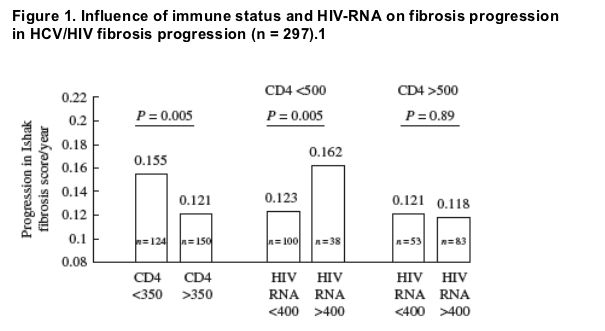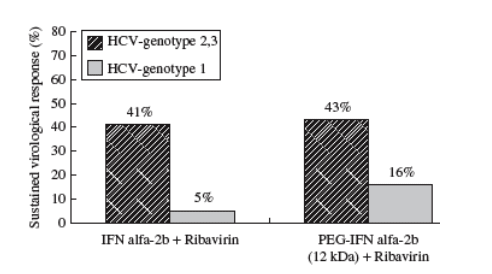| |
HCV/HIV-coinfection-is there a state of the art after APRICOT and RIBAVIC?
|
| |
| |
Journal of Antimicrobial Chemotherapy Advance Access published August 22, 2005
S. Mauss1* and J. K. Rockstroh2
1Center for HIV and Hepatogastroenterology, Grafenberger Allee 128a, 40237 Duesseldorf,
Germany; 2Department of Medicine I, University of Bonn, Germany
ABSTRACT
Today hepatitis C is one of the unsolved medical problems and results in a significant number of deaths in the HIV population, particularly in southern Europe and the USA, where the prevalence of HCV/HIVcoinfection
in the HIV population ranges from 30-50%. Recent trials using pegylated interferon alfa in combination with low dose ribavirin have achieved overall sustained response rates of up to 42%.
However, high discontinuation rates, adverse events associated with mitochondrial toxicities or treatment of patients with advanced cirrhosis may decrease response to treatment and result in serious adverse events. Optimizing antiretroviral therapy before the start of interferon-based therapy and active management of adverse events will reduce complications and improve treatment success. (ED NOTE from Jules Levin: I suggest considering HCV therapy before HAART may reduce complications & improve HAART success & help the liver).
The use of higher ribavirin doses and longer treatment periods should be systematically studied to improve hepatitis C therapy in coinfected patients in the near future.
Lessons to be learned and directions for the near future
To improve treatment results with interferon-based therapy in HCV/HIV-coinfection, active management of adverse events and motivation of the patient are crucial factors for avoiding premature therapy discontinuations, as found in RIBAVIC.
Treatment should not be initiated too late in the course of the disease as this may reduce overall response to therapy and increase the incidence
of adverse events, in particular in patients with advanced cirrhosis. In addition, optimal antiretroviral therapy should minimize toxicities by avoiding didanosine-and whenever possible stavudine and zidovudine-which have been shown to be associated with an increased risk of hyperlactataemia or anaemia, respectively.
Standard doses of ribavirin (1000-1200 mg/ day)-as used in HCV-monoinfection-may improve treatment results, as suggested in a recently published Spanish trial.14 In addition, in virologically responding patients at week 12, prolonged treatment periods for patients with genotype 2/3 may increase the sustained viral response rate by reducing the relapse rate. This is suggested by the low number of relapses for HCV genotype 2 and 3 patients treated for 48 weeks in APRICOT (2%), compared with trials treating these patients only for 24 weeks, where a relapse rate as high as 29% has been reported.15 Similarly,
prolonging therapy beyond 48 weeks in patients with genotype 1 may be an option to reduce the relapse rate in HCV-genotype 1 patients. This strategy is currently being assessed in strategic trials.
ED NOTE from Jules Levin: one additional point. Adherence is crucial to successful therapy, achieving SVR, sustained viral response. 100% adherence should be goal. Since therapy is only for time-limited period, adherence is perhaps more crucial than in HIV. With 100% adherence studies have shown increases in response rates of up to 50%.
Introduction
Chronic hepatitis C is a disease with two faces. On the one hand, it is the number one reason for liver transplantation worldwide, and on the other, a relevant proportion of patients chronically infected with the hepatitis C virus will not develop liver cirrhosis or hepatocellular carcinoma but die from other diseases. However, HIV-coinfection may worsen the course of hepatitis C, particularly in patients with marked cellular immunosuppression leading to faster progression of fibrosis and earlier development of cirrhosis.
(Figure 1).1-4

Successful antiretroviral therapy may slow fibrosis progression and reduce the incidence of liver-associated mortality, most probably due to an improvement of the cellular immune status of the coinfected patients (Figure 2).5,6(ED NOTE from Jules Levin: it remains to be seen whether HAART slows fibrosis progression. This question has not been well researched. Several studies in the past year found this, but many studies previously conducted found HIV accelerates HCV. ART may have a dual effect, immune restoration but also hepatotoxicity. I'm not convinced these recent studies adequately considered the factors involved in accelerated fibrosis nor in the heterogeneity of coinfected patients. Just last week several coinfection studies were published & liver disease associated death in the HAART era was high). In the era of antiretroviral combination therapy, liver failure due to chronic hepatitis C is one of the unsolved medical problems and results in a significant number of deaths, particularly in southern Europe and the USA where the prevalence of HCV/HIV-coinfection in the HIV population ranges from 30-50% (Figure 3).7 In a recently published paper from France on the mortality of HIV patients in 2000, HCV was the third most frequent cause of death, accounting for 90/964 (9.3%) patients in the French hospital database.8 Therefore, treatment strategies for hepatitis C in HIV-coinfected patients are urgently needed.
Results from APRICOT and RIBAVIC
Before the introduction of pegylated interferons, treatment results in HCV/HIV-coinfected patients were clearly inferior to the results from HCV-monoinfected patients and were widely regarded as disappointing. In addition, trials in HCV/HIV-coinfected patients were mostly uncontrolled and only had a small sample size, limiting the scientific and medical conclusions to be drawn from their
results. The results of two large controlled trials on HCV/HIV coinfected
patients-APRICOT and RIBAVIC-have been reported for the first time.9,10 In both trials, HCV/HIV-coinfected patients were treated for 48 weeks irrespective of HCV genotype.
The ribavirin dose in both trials was 800 mg/day, which is lower than the standard dose used in monoinfection due to toxicity concerns related to the interaction between ribavirin and nucleoside reverse transcriptase inhibitors.11,12
APRICOT is an international, multicentre trial enrolling 860 patients to compare pegylated interferon alfa-2a plus ribavirin versus pegylated alfa-2a versus interferon alfa-2a plus ribavirin. Treatment duration was 48 weeks independent of HCV genotype.
The results from APRICOT-with an overall sustained viral response of 40% in the pegylated interferon alfa-2a plus ribavirin arm-are the best achieved so far in HCV/HIV-coinfected patients (Figure 4). In HCV-genotype 2/3, the sustained viral response was 62%, whereas in the more difficult-to-treat HCV-genotype
1 patients the sustained viral response rate was 29%. Compared with these results, the success rate in RIBAVIC-an investigator-initiated trial in France enrolling 416 patients in two arms comparing pegylated interferon alfa-2b plus ribavirin versus interferon alfa-2b plus ribavirin-were disappointing. In the pegylated interferon treatment arm, sustained response rates for HCV-genotype
1 patients were 17% and for HCV-genotype 2/3 patients 44% (Figure 5). However, there was a markedly higher rate of early treatment discontinuations in RIBAVIC (37%) compared with APRICOT (15%). The differences in premature discontinuations in the two studies were predominantly not due to serious adverse events, but other reasons mainly related to the patient's decision to
stop therapy or not to return. In RIBAVIC, 16% discontinued therapy due to serious adverse events, compared with 13% in APRICOT. Patients in RIBAVIC more frequently showed bridging fibrosis or cirrhosis (40%) compared with APRICOT (16%). These differences may at least partially explain the different treatment outcomes in the two trials.
In patients with cirrhosis, who generally tend to have a lower response to therapy, the sustained virological response rate in APRICOT was 30%, which is 10% below the overall response rate, but still substantial in these patients often lacking access to liver transplantation.


Two specific entities for adverse events unique to the population of HCV/HIV-coinfected patients were observed in APRICOT and RIBAVIC, in addition to the commonly found adverse events related to interferon and ribavirin. An unexpected adverse event was the occurrence of hepatic decompensations in a substantial number of patients (APRICOT n = 14, RIBAVIC n = 9). This
finding was unexpected as it has not been reported in HCV monoinfection
trials. From APRICOT a more detailed analysis of risk factors associated with hepatic decompensation is available. 13 All hepatic decompensations occurred in patients with liver cirrhosis. In a logistic regression analysis, the baseline risk factors associated with hepatic decompensation were either markers of
advanced cirrhosis or treatment with didanosine. This led to the recommendation that patients with advanced liver disease should be monitored closely during interferon-based therapy, and didanosine should be avoided in these patients. Other adverse events not commonly found in patients with HCV-monoinfection are hyperlactataemia and acute pancreatitis, thought to be caused by
mitochondrial toxicity. In a multivariate analysis carried out in RIBAVIC, treatment with didanosine was again identified as a significant risk factor.10 A likely explanation for the toxicity of didanosine in coinfected patients on interferon and ribavirin may be the increased phosphorylation of didanosine in the presence of
ribavirin, which was demonstrated in vitro.11 However, it should be pointed out that in APRICOT there were no differences in the number of hepatic decompensations between the interferon monotherapy arm and the two arms containing ribavirin.
References
1. Brau N, Rodriguez-Torres M, Salvatore M et al. Control of HIV viral load through highly active antiretroviral therapy (HAART) slows down liver fibrosis progression in HIV/HCV-coinfection and makes it the same as in HCV-monoinfection. In: Programs and Abstracts of the European Association for the Study of the Liver, Berlin 2004. Abstract 91, p 23. European Association for the Study of the Liver, Geneva, Switzerland.
2. Eyster ME, Diamondstone LS, Lien JM et al. Natural history of hepatitis C virus infection in multi-transfused hemophiliacs: effect of coinfection with human immunodeficiency virus. A multicenter hemophilia cohort study. J Acq Immunodef Syndr 1993; 6: 602-10.
3. Poynard T, Mathurin P, Lai CL et al. A comparison of fibrosis progression in chronic liver diseases. J Hepatol 2003; 38: 257-65.
4. RockstrohJK, SpenglerU,SudhopTet al.Immunosuppressionmay lead to progression of hepatitis C virus associated liver disease in hemophiliacs
coinfected with HIV. Am J Gastroenterol 1996; 91: 2563-8.
5. Benhamou Y, DeMartinio V, Bochet M et al. Factors affecting liver fibrosis in human immunodeficiency virus and hepatitis C virus coinfected patients: impact of protease inhibitor therapy. Hepatology 2001; 34: 283-7.
6. Qurishi N, Kreuzberg C, Luchters G et al. Effect of antiretroviral therapy on liver-related mortality in patients with HIV and hepatitis C coinfection.
Lancet 2003; 362: 1708-13.
7. Rockstroh JK, Mocroft A, Soriano V et al. Influence of hepatitis C on HIV disease progression and response to antiretroviral therapy. J Infect Dis 2005; in press.
8. Lewden C, Salmon D, Morlat P et al. Causes of deaths among human immunodeficiency virus (HIV)-infected adults in the era of potent antiretroviral therapy: emerging role of hepatitis and cancers, persistent role of AIDS. Int J Epidemol 2005; 34: 121-30.
9. Torriani FJ, Rodriguez-Torres M, Rockstroh JK et al. Peginterferon alfa-2a plus ribavirin for chronic hepatitis C virus infection in HIV-infected patients. N Engl J Med 2004; 351: 438-50.
10. Carrat F, Bani-Sadr F, Pol S et al. Pegylated interferon alfa-2b vs standard interferon alfa-2b, plus ribavirin, for chronic hepatitis C in HIV-infected patients: a randomized controlled trial. JAMA 2004; 292:
2839-48.
11. Hoggard PG, Kewn S, Barry MG et al. Effects of drugs on 20, 30-dideoxy-20,30-didehydrothymidine phosphorylation in vitro. Antimicrob Agents Chemother 1997; 41: 1231-6.
12. VogtMW,Hartshorn KL, FurmanPAet al. Ribavirin antagonizes the effect of azidothymidine on HIV replication. Science 1987; 235: 1376-9.
13. Mauss S, Valenti W, DePamphilis J et al. Risk factors for hepatic decompensation in patients with HIV/HCV coinfection and liver cirrhosis during interferon-based therapy. AIDS 2004; 18: F21-5.
14. Laguno M, Murillas J, Blanco JL et al. Peginterferon alfa-2b plus ribavirin compared with interferon alfa-2b plus ribavirin for treatment of HIV/HCV co-infected patients. AIDS 2004; 18: F27-34.
15. Voigt E, Schulz C, Klausen G et al. Pegylated interferon a 2b plus ribavirin for treatment of chronic hepatitis C in HIV-coinfected patients: a German multicenter trial. In: First International Workshop on HIV and Hepatitis Co-Infection, Amsterdam, 2004. Abstract CI15. Virology Education, Utrecht, The Netherlands.
|
|
| |
| |
|
|
|